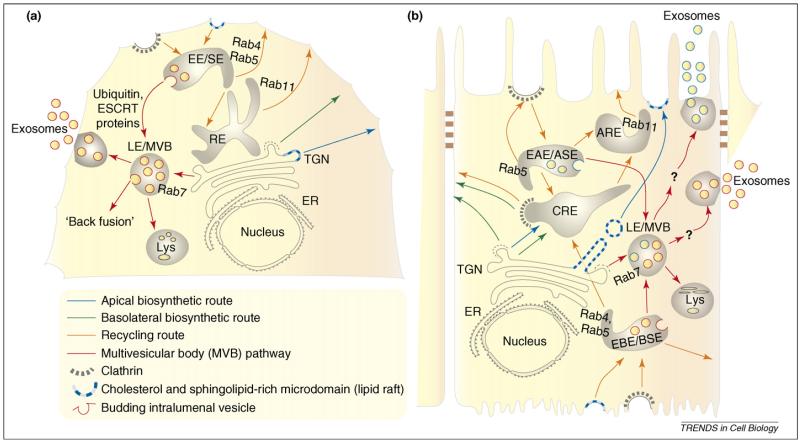Figure 1.
The endosomal network and the multivesicular bodies (MVBs) pathway. Non-polarized cells (a) have a simpler endosomal system than polarized cells (b). (a) Newly synthesized proteins are transported from the trans-Golgi (TGN) network to the plasma membrane (green and blue arrows). Clustering of proteins into lipid rafts (blue) or interaction of specific motifs in the proteins with clathrin adaptors (green) act as sorting signals. Recycling of endocytosed membrane proteins occurs from early endosomes [also known as sorting endosomes, (EE/SE)] and recycling endosomes (RE, orange arrows). Proteins destined for degradation are sorted into membrane invaginations of the EE/SE. These intralumenal vesicle-containing regions of the EE/SE eventually mature into late endosomes, also known as multivesicular bodies (LE/MVBs). Ubiquitylation of proteins and the ESCRT machinery helps to sort cargo into LE/MVBs and might also participate in their biogenesis [15,85]. Not all ILVs are destined for lysosomal degradation. Fusion of ILVs with the late endosomal limiting membrane, a process called ‘back-fusion’, is essential for the cytoplasmic delivery of certain proteins and viruses [10]. In many cells, the limiting membrane of LE/MVBs fuses with the plasma membrane, releasing ILVs into the extracellular space; these vesicles are now referred to as exosomes. (b). Epithelial cells have distinct apical and basolateral membrane domains separated by tight junctions (brown), and a complex endosomal system that is essential for the establishment and maintenance of polarity [1]. In the biosynthetic route, at the TGN, specific signals help to sort proteins into carrier vesicles that are transported to either the apical or the basolateral membrane. GPI-anchors or association with lipid rafts transport proteins to the apical domain (blue) and proteins containing motifs such as NPXY, YXXΦ, LL and L which interact with clathrin adaptors are transported to the basolateral domain (green) [3]. In the endocytic route, apical and basolateral proteins are first internalized into early apical or basolateral endosomes [also known as sorting endosomes, (EAE/ASE and EBE/BSE)]. Recycling cargo is transported to common recycling endosomes (CREs) and sorted into separate apical and basolateral recycling routes. In epithelial cells, the apical recycling route also includes the Rab11+ apical recycling endosome (ARE) [3]. Little is known about sorting of ubiquitylated cargo, the ESCRT machinery or the biogenesis of LE/MVBs in polarized cells, and phenomena such as back-fusion have yet to be demonstrated. Epithelial cells originating from different organs do release exosomes at both the apical and the basolateral surfaces [11,23,61-64]. Apical and basolateral endocytic pathways have been shown to intersect at the level of late endosomes in epithelial cells [31]; however, because exosomes released apically have a different protein composition from those released at the basolateral surface [11,64], it is also possible that different populations of MVBs generate exosomes destined for apical or basolateral release (see text and Figure 2 for a discussion on polarized sorting into exosomes).

